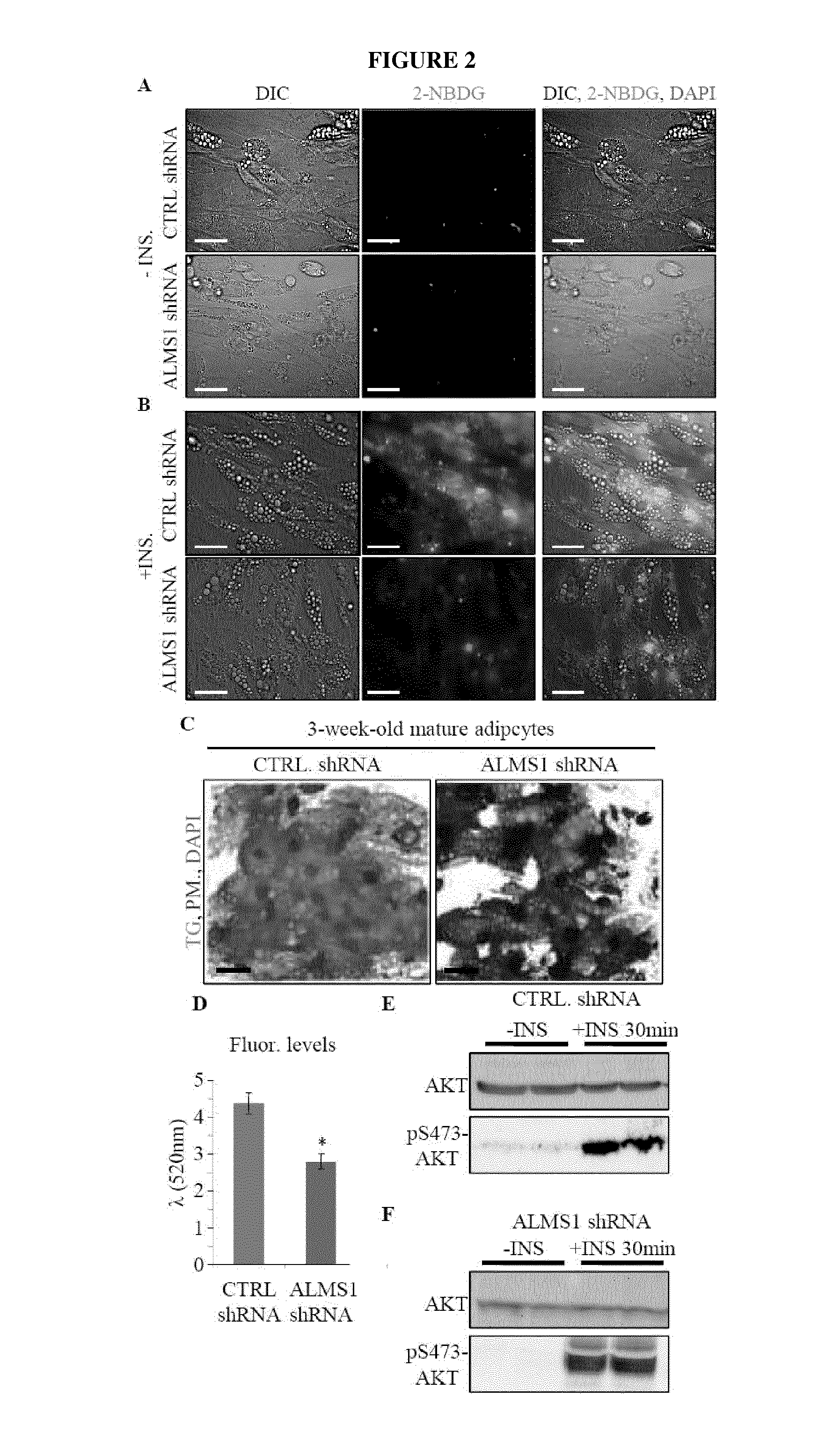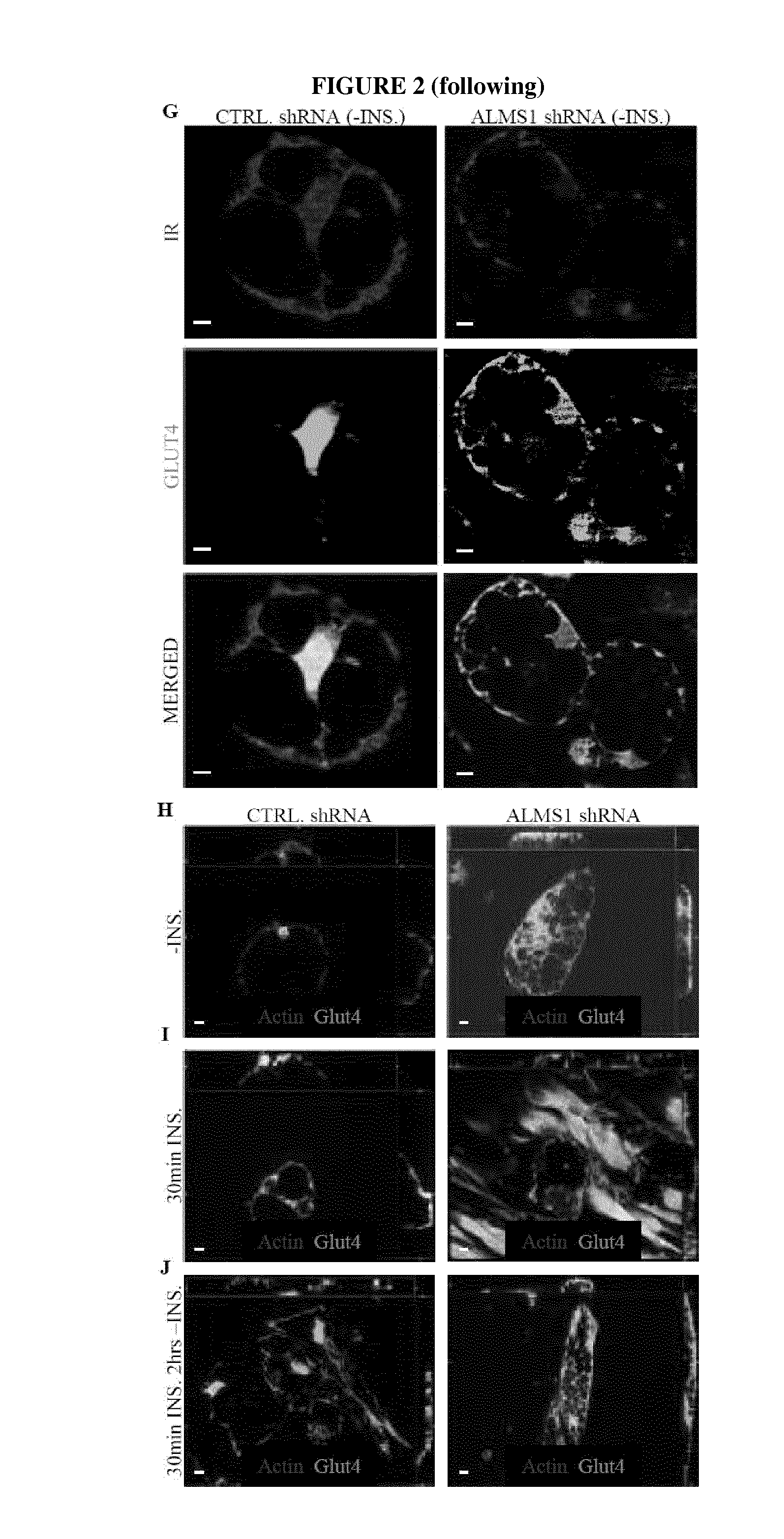New target for diabetes treatment and prevention
a diabetes and new target technology, applied in the field of medicine, can solve the problem of inability to simultaneously binding both proteins, and achieve the effect of preventing the assembly of almsomes
- Summary
- Abstract
- Description
- Claims
- Application Information
AI Technical Summary
Benefits of technology
Problems solved by technology
Method used
Image
Examples
example 1
Alms1foz / foz Mice Display Severe Specific Adipose Tissue Insulin Resistance Even in the Absence of Obesity
[0145]Alms1foz / foz mice and Alms1+ / + (WT) littermates were maintained on a C57BL / 6J background in the animal facility on a 12 hourly light / dark cycle. Mice had free access ad libitum to water and either normal chow containing 5.4% fat, energy content 12 MJ / kg (Gordon's rat and mouse maintenance pellets, Gordon's specialty stockfeeds, Australia) or high fat diet (HFD) containing 23% Fat, High Simple carbohydrate, 0.19% cholesterol, energy content 20 MJ / kg (SF03-020, Specialty feeds, Australia). Primers flanking the foz mutation were used for PCR genotyping: forward ACA ACT TTT CAT GGC TCC AGT (SEQ ID No 13); reverse TTG GCT CAG AGA CAG TTG AAA (SEQ ID No 14).
[0146]Six month old obese and young (foz / foz mice and wildtype (WT) littermates were used to investigate what primary metabolic impairment leads Alms1foz / foz mice to develop T2DM. Six month old Almsfoz / foz mic...
example 2
Silencing of Alms1 in Human Adipocytes Blocks Glucose Uptake Through Impaired GLUT4 Cellular Sorting
[0148]Materials.
[0149]From Molecular Probes, Invitrogen: Acridine Orange, Image-iT® LIVE Plasma Membrane and Nuclear Staining Labeling Kit, 2-NBDG (2-(N-7-nitrobenz-2-oxa-1, 3-diazol-4-yl)amino)-2-deoxyglucose), Hoechst 33258 and Cell Light™ Early Endosomes-RFP* BacMam 2.0*; Catalog #: A3568, 134406, N13195, H3569 and C10587. From Lonza: AdipoRed™ Assay Reagent (Catalog #: PT-7009). Lentiviral particles from Santa Cruz Biotechnology, INC.: ALMS1 shRNA (h) Lentiviral Particles, TBC1D4 shRNA (h) Lentiviral Particles and Control shRNA Lentiviral Particles-A; Catalog #: sc-72345-V, sc-61654-V and sc-108080 respectively. From Tocris Biosciences: Nigericin Sodium Salt (Catalog #: 4312).
[0150]Biochemical Tests.
[0151]Mice were tested for insulin resistance by the insulin tolerance test (ITT) and intraperitoneal glucose tolerance test (IPGTT). For the ITT, mice were fasted 4 hours with no acce...
example 3
ALMS1 is Required for TBC1D4 Targeting to the PM in Response to Insulin Signaling
[0173]To understand the molecular mechanism underlying the effect of ALMS1 inactivation on GLUT4 localisation, the inventors identified interacting partners of ALMS1 in human adipocytes. Immunoprecipitation (IP) using ALMS1 as the bait was performed using young mature human adipocytes (4 days after differentiation trigger) followed by identification of ALMS1 interacting partners by mass spectrometry. Amongst proteins were immunoprecipitated with ALMS1, was TBC1D4, a known AKT substrate GTPase required for proper retention of GLUT4 in the GLUT4 sorting vesicles (GSVs) and for the translocation of GLUT4 to the cell membrane for intracellular glucose uptake.
PUM
| Property | Measurement | Unit |
|---|---|---|
| body weight | aaaaa | aaaaa |
| weight | aaaaa | aaaaa |
| temperature | aaaaa | aaaaa |
Abstract
Description
Claims
Application Information
 Login to View More
Login to View More - R&D
- Intellectual Property
- Life Sciences
- Materials
- Tech Scout
- Unparalleled Data Quality
- Higher Quality Content
- 60% Fewer Hallucinations
Browse by: Latest US Patents, China's latest patents, Technical Efficacy Thesaurus, Application Domain, Technology Topic, Popular Technical Reports.
© 2025 PatSnap. All rights reserved.Legal|Privacy policy|Modern Slavery Act Transparency Statement|Sitemap|About US| Contact US: help@patsnap.com



